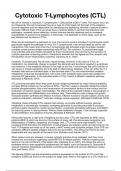Cytotoxic T-Lymphocytes (CTL)
My cell of interest is Cytotoxic T-Lymphocytes / CD8 positive (CD8+) T cells. The reason why I am
so intrigued by this cell is because they are a type of white blood cell that part of the adaptive
immune response and are responsible for identifying and destroying infected or abnormal cells in
the body. Without these CTLs we would have a reduced ability to combat viral infections and
pathogens, impaired cancer detection, limited immune memory response and an increased
susceptibility to autoimmune diseases. In this essay I will elaborate on other ideas, such as the
key features and functions of CTLs.
When we are exposed to a pathogen or virus, the immune system activates T-Lymphocytes which
speci cally targets the pathogen or virus. For T-Lymphocytes, they are activated by cell-to-cell
interactions; this means that when the T-Lymphocytes get activated when its antigen receptor
complex comes across antigen presenting cells (APCs). The cytotoxic T-Lymphocytes target
virus-infected cells and initiate cell death by three mechanisms, they do this by the secretion of
cytolytic granules containing perforin, interactions between the Fas ligand and Fas receptor and
the secretion of pro-in ammatory cytokines. (Janeway et al., 2001)
Cytotoxic T-Lymphocytes, like all cells, require energy. However, in the case of CTLs, its
metabolism can drastically change to support the demands and functions required in a particular
circumstance. If the metabolic demand is too high or too low, it could impair the cell’s function or
can cause or prevent apoptosis and may lead to in ammatory diseases. CTLs can either be in a
dormant state and an activated state, in the dormant state CTLs use mitochondrial oxidative
metabolism of glucose and glutamine; with most of the metabolic precursors fully oxidised for
maximal ATP generation. In the activated state of CTLs, there’s a di erent metabolic pathway.
(Michalek & Rathmell, 2010).
CTLs become activated when they come across antigens presented by major histocompatibility
complex (MHC) proteins on the surface of APCs. This then causes a cascade marked by protein
tyrosine phosphorylation; this is the translocation of transcription factors to the nucleus and the
production of reactive oxygen intermediates. The e ect of the cascade initiates a new program of
gene expression and di erentiation into e ector cells. These e ector cells undergo cell growth,
increased protein synthesis and e ector functions. E ector functions include cytolytic activity and
cytokine production, activated T cells also undergo clonal expansion. (Michalek & Rathmell, 2010).
Therefore, these activated CTLs require more energy, to provide su cient energy, glucose
metabolism is dramatically increased, increasing glycolysis to provide precursors to produce
pentose sugars required for nucleic acid synthesis, via pentose phosphate pathways, and NADH
for reducing power in lipid synthesis. Without these metabolic changes, it can strongly suppress
T-cell proliferation and adaptive immunity. (Michalek & Rathmell, 2010).
Killing cells requires a high level of targeting and accuracy. CTLs are regulated by MHC class I
proteins (MHC-I) which are found on the surface of every cell, this allows easy recognition and
di erentiation of healthy, dangerous and foreign cells. CTLs have clonal type speci c T-cell
receptors (TCR) that allow the distinction of self antigens and antigens which are abnormal for the
host. TCR ligands are made up of two parts; a MHC moiety and a peptide antigen. Each TCR can
recognise di erent peptide antigens bound to the same MHC. This allows the TCR to be both
degenerate and very speci c at the same time. (Anikeeva and Sykulev, 2011)
When calcium ions are released, it causes cytolytic granules to be polarised, and they move
towards the microtubule-organising centre (MTOC) to release perforin. Perforin creates pores/
lesions in the cell membrane of the target cells, (Janeway et al., 2001), this allows the entry of
proteases which cause apoptosis (programmed cell death), such as Granzyme B. Granzyme B
cleaves important intracellular substrates controlling cell death and survival. (Martínez-Lostao,
Anel, and Pardo, 2015)
Fas ligands (CD95L) are transmembrane proteins expressed on the surface of CTLs and Fas
receptors (CD95) are found on the surface of target cells. When a Fas ligand on a CTL binds to a
ff fi
ff flff fi ff ff flff ff ff ffi
ff fi




